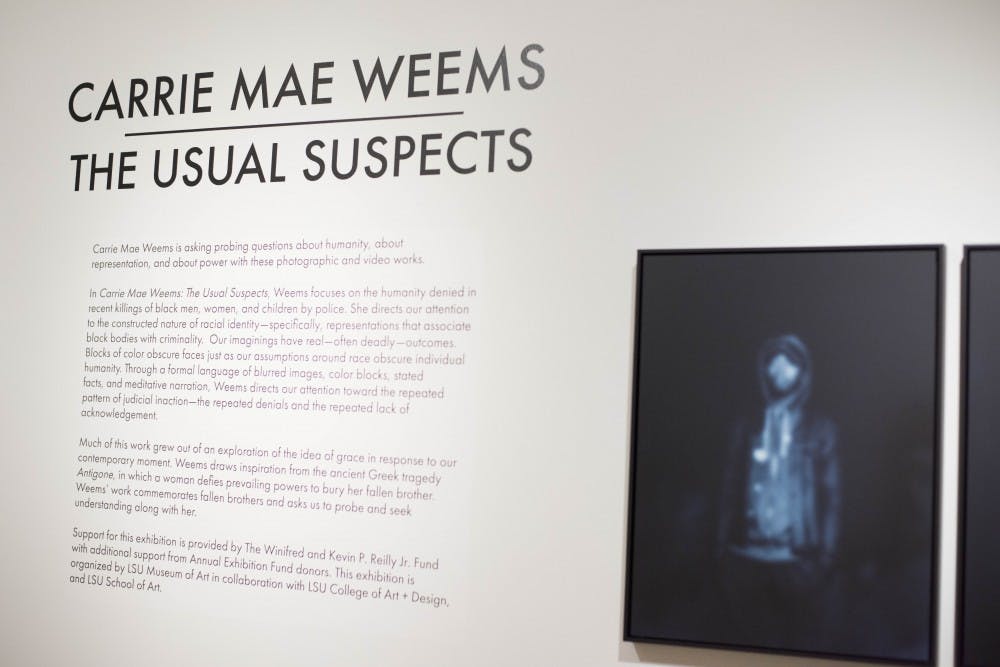A new exhibit at the Kennedy Museum of Art is illustrating the ways in which people assign meaning to colors and the effects of such perceptions.
Carrie Mae Weems’ The Usual Suspects exhibition opened Jan. 11 in the Kennedy Museum of Art at The Ridges.
The exhibition is a powerful, pensive experience. One enters and is immediately confronted with a five-piece panel featuring still images of the dash cam footage of Laquan McDonald’s death. The caption asks the viewer to take a moment and think about what each image has to say.
Weems uses color blocking in her photographic work. It is particularly powerful. Blocks of primary colors on black-and-white portraits, some featuring faces of fame such as Dinah Washington, convey a message that is layered and nuanced — people assign meaning to color. People make decisions and have impulses based off those meanings.
Another set of panels feature the real police reports of the deaths of Michael Brown, Trayvon Martin and Sandra Bland, among others, which demonstrates the chilling reality that all of those cases have similar features.
The exhibition culminates in Weems’ video, People of a Darker Hue. People of a Darker Hue is a three-part, roughly 15-minute video that uses narration, music, images of anonymous people, images of a man running on a treadmill in a closed space and actual footage of nationally known cases of police violence, such as Alton Sterling and Philando Castile.
In People of a Darker Hue, Weems makes it a point to notice the similarities in each case. “Always stopped, always charged” is her refrain. She also uses humanizing language and points to the roles the people shown in the video played in their own lives — mother, son, uncle, cousin, etc. Weems ends the video with commemorations to those whose lives were lost to police violence, to black men and “those who have the ability to endure.”
Weems is an internationally known American contemporary artist who has produced works for about three decades. The Usual Suspects is just a small fraction of her work, Lisa Quinn, educational programs coordinator for the Kennedy Museum of Art, said.
Organizing the exhibition has been years in the making, Courtney Kessel, Ohio University Art Galleries gallery coordinator, said. She first made contact with Weems more than three years ago. Weems has been on campus before, Kessel said, as a juror for an exhibition in the 1990s. Now, her involvement with OU has come full-circle, Kessel said.
If gallery-goers want to familiarize themselves with Weems and her work, both Kessel and Quinn recommend doing a quick Google search and watching Weems’ performance piece, Grace Notes: Reflections for Now.
The exhibition contains disturbing content. Viewers are warned of that for their own well-being, but not to minimize the reactions the content may provoke.
“It's very disturbing that these things are happening and what we're trying to do here is be a part of the conversation and be part of the discussion about these things,” Quinn said. “(Weems) speaks eloquently, bringing grace into the conversation about how we deal with the violence that we are faced with in our world today.”
Angela Schmitz, a senior studying marketing and data analytics, called The Usual Suspects “the humanitarian wake-up call we all need.”
The exhibition is just another piece of Weems’ work and what’s to come with Weems’ week-long residency at OU.
Weems will also give a lecture in the Baker Center Ballroom on Jan. 22 at 7 p.m. A reception for The Usual Suspects will be held in the Kennedy Museum of Art on Jan. 24 at 6 p.m.
A master class performance through the School of Theater will be held on Jan. 25 at 8 p.m. in The Forum Theater in the Radio-Television Center. Tickets may be reserved online and seats are first-come-first-serve. All events are free through Arts for Ohio.






